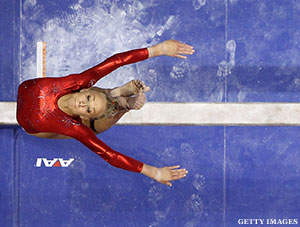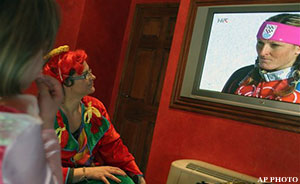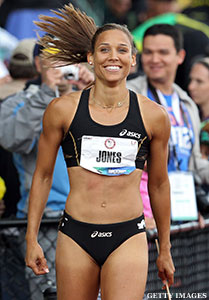The American sports world just finished celebrating the 40th anniversary of Title IX, legislation that aimed to end gender segregation at public schools and universities. Nearly 200,000 women play on 9,274 NCAA teams, the highest number ever recorded. According to the High School Athletics Participation Survey, girls made up 36 percent of high school athletes 20 years ago. Now, that number has reached 41 percent.

But while more women are bringing their game to the tracks, fields and courts across the U.S., they aren't bringing it to the couch. When it comes to watching sports on television, it's mostly a man's game. A new study from Erin Whiteside at the University of Tennessee and Marie Hardin from Penn State University reveals a lot about women's behavior when it comes to watching sports on TV, and perhaps most interestingly, the Olympics.
The researchers interviewed 19 women between the ages of 26 and 43. The majority of women admitted household chores and family responsibilities were higher on their list than watching sports on TV. And rather than scheduling their sports viewing time around a particular team, the women tend to catch games or commentary when it's convenient, or to spend a little extra time with their spouses.

"What we found was that sports fandom for these women was not associated with leisure as much as it was with the maintenance of relationships, notably with the key men in their lives," the researchers said. Their subjects were most likely to watch football games and NASCAR races, and although a few of them were high school or college athletes, they didn't spend a significant amount of time reading about or watching their favorite sports.
A few of the women expressed a bit of frustration about the amount of, say, football they watch with their husbands in relation to the number of televised figure skating they've watched or ballet performances they've attended, though a small number of participants were adamant that they were often glued to football games while their husbands couldn't care less. One participant even questioned her own behavior when she caught herself enjoying the World Cup.

"I was flipping stations, and it came up, and I said, ‘Oh.’ Came in and said, ‘I’ll see what's going on,’ and the next thing I know, we’re three games later, and I'm still sitting there. I'm like, OK, what's wrong here?" she said.
But when the Olympics are splashed across the screen, interest peaks for female viewers. Everything changes. If you're not a sports junkie, it's easier to follow the Olympics because you can focus on a few star athletes every four years, rather than following the complexities of major league sports, and a news cycle that even the most dedicated sports fans can't always ingest in its entirety.
"The vignettes that bring viewers up to date on the athletes to follow, and the relevant highlights of their personal struggles during their journey to the Games, appeal to women who don’t have time to follow athletes during an entire season, much less over several years," Alice Park writes in a Time magazine piece about the study.

The women from this study said they prefer to watch women's Olympic sports that showcase the femininity and grace of the athletes -- figure skating, gymnastics and tennis, etc. Many women may admire the tough beauties of the London Games like Hope Solo, Allyson Felix and Lolo Jones, but when it comes to making time to watch TV, it's gymnasts Alicia Sacramone and Nastia Lukin and tennis star Maria Sharapova that may get more attention from female viewers. When it comes to watching women's sports throughout the year, the participants expressed little interest, but also claimed exposure -- or lack of it -- plays a significant part in this.
"I think if it was on more then we would get into it more. The same way with men's sports," one woman said. When men's sports take up more than 90 percent of TV news coverage, it's not surprising that none of the participants watch women's sports with their husbands.
We might be seeing more female reporters and anchors presenting sports stories, and more women and girls playing at the high school and college levels, but the audience at home isn't keeping up -- much to the disappointment of advertisers who would love to capture the attention of female viewers. They may not always have the remote, but they're usually the ones with the buying power.




